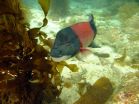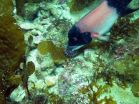(Press-News.org) A sex-changing fish called California sheephead (Semicossyphus pulcher) plays a vital role in the food web of kelp forests along the Pacific coast. Commonly found in the waters from Baja California to Point Conception -- although they can sometimes be found as far north as Monterey Bay -- sheephead feed on sea urchins, whose grazing habits can wreak havoc on community composition in kelp forests.
A new study by UC Santa Barbara research biologist Jenn Caselle uses data from three decades of research to document differential exploitation and recovery of sheephead populations in the Santa Barbara Channel in response to marine reserves and fishing regulations. Her research on sheephead appears today in the Proceedings of the Royal Society B: Biological Sciences.
"It's a really iconic species in our local kelp forests and it's fascinating because it's big, it's beautiful and it changes sex," Caselle said. Born female, sheephead morph into males at various stages in the lifecycle as determined by environmental conditions and pressures. "There's a lot going on with this species, and its effect on the kelp forest food web is essential," she added
Caselle and lead author Scott Hamilton, previously a postdoctoral researcher at UCSB and now a faculty member at Moss Landing Marine Laboratories near Monterey, show that as sheephead increase in size -- particularly when they surpass the minimum size limit of the fishery -- they are able to eat bigger urchins, and more of them, as revealed by analysis of their gut content.
"That's probably because large sheephead can physically handle the urchins," Caselle said. "We call it gape size, meaning their mouth is big enough to get around them."
The researchers began their work in 2007 by investigating sheephead population dynamics and life histories in response to fishing pressure. They also have done studies on species' movements and whether marine protected areas could help sheephead recover from overfishing.
The current paper combines previous findings with new work using visual surveys and path analysis to quantify the direct and indirect effects of sheephead on sea urchins and macroalgal assemblages. The research illustrates the context-dependent ecological role of sheephead in Southern California kelp forests. When predators such as sheephead are fished, not only does abundance diminish, Caselle noted, but size structure is also reduced because fisheries usually target bigger individuals.
"The main point of our work is not necessarily about fishing reducing abundance; it's about how fishing reduces size structure," she said. "If you have a species whose predation rate depends on that size, you can have strong trophic effects without even thinking about abundance changes."
The way in which fishing alters size-structured food web interactions has implications for the structure and function of kelp forest ecosystems. "Our argument emphasizes that management strategies protecting large sheephead -- such as marine reserves or increases in the minimum size limit -- may help alleviate overgrazing in temperate kelp forest systems," Caselle concluded.
"The reduction in size structure can have important effects on prey structure as well, apart from reductions in numbers," she added. "Sheephead are very important players in the kelp forest. By keeping urchins in check, they maintain healthy kelp, which in turn provides habitat for many, many other species."
INFORMATION:
This research was supported by a grant from the California Ocean Protection Council and California Sea Grant, a program of the National Oceanic and Atmospheric Administration, as well as the David and Lucille Packard Foundation.
Recent research from the University of Alberta reveals that contrary to current scientific knowledge, there's no atmospheric lead pollution in the province's oil sands region.
William Shotyk, a soil and water scientist who specializes in heavy metal pollution, examined sphagnum moss from 21 separate peat bogs in three locations around the oil sands area, near open pit mines and processing facilities.
After measuring the heavy metal content in the moss samples in his ultra-clean lab at the University of Alberta, Shotyk, based in the Faculty of Agricultural, Life and ...
A University of Colorado Cancer Center study being presented at the San Antonio Breast Cancer Symposium shows that triple negative breast cancer cells process tryptophan to promote survival while traveling through the body in order to seed new tumor sites.
"I'm not saying that people with metastatic breast cancer shouldn't eat turkey during the holidays, but triple-negative breast cancer appears to have found a way to process tryptophan more quickly, equipping cancer cells to survive while in circulation, which allows them to metastasize," says Thomas Rogers, the paper's ...
DALLAS - Dec. 10, 2014 - UT Southwestern Medical Center microbiologists have identified key bacteria in the gut whose resources are hijacked to spread harmful foodborne E. coli infections and other intestinal illnesses.
Though many E. coli bacteria are harmless and critical to gut health, some E. coli species are harmful and can be spread through contaminated food and water, causing diarrhea and other intestinal illnesses. Among them is enterohemorrhagic E. coli or EHEC, one of the most common foodborne pathogens linked with outbreaks featured in the news, including ...
An anomaly spotted at the Large Hadron Collider has prompted scientists to reconsider a mathematical description of the underlying physics. By considering two forces that are distinct in everyday life but unified under extreme conditions like those within the collider and just after the birth of the universe, they have simplified one description of the interactions of elementary particles. Their new version makes specific predictions about events that future experiments at the LHC and other colliders should observe and could help to reveal "new physics," particles or processes ...
BERKELEY -- Future fitness trackers could soon add blood-oxygen levels to the list of vital signs measured with new technology developed by engineers at the University of California, Berkeley.
"There are various pulse oximeters already on the market that measure pulse rate and blood-oxygen saturation levels, but those devices use rigid conventional electronics, and they are usually fixed to the fingers or earlobe," said Ana Arias, an associate professor of electrical engineering and computer sciences and head of the UC Berkeley team that is developing a new organic optoelectronic ...
New Haven, Conn. - A new combination of cancer drugs delayed disease progression for patients with hormone-receptor-positive metastatic breast cancer, according to a multi-center phase II trial. The findings of the randomized study (S6-03) were presented at the 2014 San Antonio Breast Cancer Symposium, held Dec. 6-9, by Kerin Adelson, M.D., assistant professor of medical oncology at Yale Cancer Center and chief quality officer at Smilow Cancer Hospital at Yale-New Haven.
The trial enrolled 118 post-menopausal women with metastatic hormone-receptor-positive breast cancer ...
PHILADELPHIA--Two-thirds of women treated for early-stage breast cancer in the U.S. receive longer radiation therapy than necessary, according to a new study published in JAMA this week from Penn Medicine researchers Ezekiel J. Emanuel, MD, PhD, and Justin E. Bekelman, MD. Their findings reveal that the vast majority of women after breast conserving surgery receive six to seven weeks of radiation therapy, despite multiple randomized trials and professional society guidelines showing that three weeks of radiation - called hypofractionated whole breast radiation - is just ...
Although the use of a type of radiation treatment that is shorter in duration and less costly has increased among women with early-stage breast cancer who had breast conserving surgery, most patients who meet guidelines to receive this treatment do not, according to a study appearing in JAMA. The study is being released to coincide with the San Antonio Breast Cancer Symposium.
Breast cancer accounts for the largest portion of national expenditures on cancer care, estimated to reach $158 billion in 2020. Breast conservation therapy is the most common treatment for early-stage ...
Researchers at Case Western Reserve University School of Medicine have uncovered the mechanism that enables the enzyme Lecithin: retinol acyltransferase (LRAT) to store vitamin A--a process that is indispensable for vision.
"Without this information, our knowledge was inadequate to understand the molecular mechanisms of blindness caused by mutations in the enzyme," said Marcin Golczak, assistant professor of pharmacology at Case Western Reserve and an author of the study.
The researchers hope the new information will be used to design small molecule therapies for degenerative ...
New research reports that liver transplant recipients with less understanding of treatment information and improper use of medications may be more likely to have trouble following the prescribed regimen. According to the study published in Liver Transplantation, a journal of the American Association for the Study of Liver Diseases and the International Liver Transplantation Society, the patients' non-adherence is linked to adverse clinical outcomes, such as organ rejection or graft loss.
During the past 30 years, improvements in surgical techniques and advances in immunosuppressive ...





